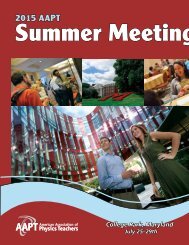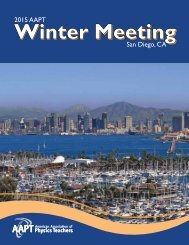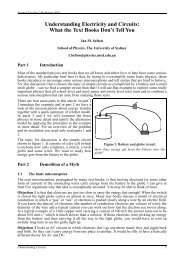GA06:1:50-2 p.m. Do Individual Thinking StrategiesConsistently Inform Reasoning Approaches?*Contributed – Mila Kryjevskaia, North Dakota State University, Department ofPhysics, Fargo, ND 58108-6050; mila.kryjevskaia@ndsu.eduMacKenzie R. Stetzer, University of MaineThis study was motivated by research findings suggesting that studentconceptual and reasoning competence demonstrated on one task often failsto be exhibited on another. Even after targeted instruction, many undergraduatephysics students fail to build reasoning chains from fundamentalprinciples even though they possess the required knowledge and skills todo so. Instead, they often rely on a variety of intuitive reasoning strategies.In this study, we examined the extent to which students employ intuitivereasoning across multiple contexts (both related and unrelated). In addition,we wanted to see if the tendency to use a particular class of reasoningapproaches (e.g., intuitive or formal) may be attributed to individual studentthinking strategies in general. Data from introductory calculus-basedphysics courses will be presented and implications for instruction will bediscussed.*This work is supported in part by the National Science Foundation under Grant Nos.DUE-1245313, DUE-1245999, and DUE-0962805.GA07:2-2:10 p.m. Metacognition and Epistemic Games in IPLSProblem SolvingContributed – Charles Bertram, University of Central Arkansas, Lewis ScienceCenter, Conway, AR 72035-0001; ajmason@uca.eduAndrew Mason, University of Central ArkansasA metacognitive exercise in problem solving was given to an introductoryphysics for life sciences (IPLS) class over the course of the fall 2013 andspring 2014 semester. The exercise featured scaffolding in the form of arubric students could use to note where they struggled in a group problemsolving effort. One of the concerns was that students who are not physicsmajors do not necessarily have the same epistemic framework as physicsmajors would for the classroom. As such, we examine written artifactsfrom the students’ reflection activities for evidence of different epistemicgames. We also describe a comparison of written artifacts to pre-post datafrom the FCI, MPEX, and CLASS surveys.GA09:2:20-2:30 p.m. Investigating the Metacognitive Calibrationof Students in Introductory CoursesContributed – Beth A. Lindsey, Penn State Greater Allegheny, Mc Keesport,PA 15131-7644; bal23@psu.eduMegan L. Nagel, Penn State Greater Allegheny“Calibration” is an aspect of metacognition that describes how well studentsassess their own knowledge. We have been engaged in a multi-yearproject to investigate the metacognitive calibration of students enrolled inintroductory physics and chemistry courses at a small campus of a largepublic university. When assessed at the end of the semester, we founda large disparity between students’ confidence in their ability to answerquestions compared to their actual ability to provide the correct answer ona large number of questions that spanned the course material. We furtherinvestigated student calibration in a series of interviews designed to examinewhich question features and student behaviors might lead studentsto assess their knowledge more accurately. Data from written questionsand one-on-one student interviews will be presented, and the implicationsthese have for future investigations into student metacognition will bediscussed.GA10:2:30-2:40 p.m. Identifying Blended Ontologies for EnergyContributed – Benjamin W. Dreyfus, University of Maryland, Department ofPhysics, College Park, MD 20742; dreyfus@umd.eduAyush Gupta, Edward F. Redish, University of Maryland, College ParkEnergy is an abstract concept, but students and experts alike reason aboutenergy using ontological metaphors: metaphors that indicate what kind ofa thing energy is. These metaphors include energy as a substance (“Thisobject has a lot of energy”) and energy as a vertical location (“It droppeddown to a lower energy”). Both of these metaphors can be productive, buteach one has its limitations. In our previous work, we have shown thatstudents and experts can productively combine the substance and locationmetaphors for energy and coordinate them coherently. Here, we examineinstances in which students are using both metaphors, and argue that,in some cases, students blend these two separate metaphors into a singleontology for energy. To determine this, we employ an integrated methodology,analyzing both the verbal metaphors and the gestures that the studentsuse.Wednesday afternoonGA08:2:10-2:20 p.m. Exploring the Role of Metacognition inQualitative Reasoning*Contributed – Thanh K. Le, University of Maine, Orono, ME 04473-4462;thanhle@maine.eduMacKenzie R. Stetzer, University of MaineMila Kryjevskaia, North Dakota State UniversityMetacognition, the monitoring and regulation of one’s thinking, plays animportant role in developing conceptual understanding and facilitatingeffective problem solving. To date, relatively little work has focused on therole of student metacognition in qualitative inferential reasoning. We havecollected audio, video, and real-time written data in order to identify instancesof socially mediated metacognition 1 that occur while introductoryphysics students work through qualitative problems. In particular, we usemulti-part questions that tend to elicit inconsistencies in student reasoning,even when students possess the requisite conceptual understanding.This work is part of a broader effort to identify methods for improving studentslearning in physics by explicitly supporting and enhancing students’metacognitive abilities. Preliminary findings as well as specific exampleswill be presented.*This work is supported in part by the National Science Foundation under Grant Nos.DUE-1245313, DUE-1245999, and DUE-0962805.1. M. Goos, P. Galbraith, & P. Renshaw, “Socially mediated metacognition: Creatingcollaborative zones of proximal development in small group problem solving,” EducationalStudies in Math. 49(2), 193-223 (2002).GA11:2:40-2:50 p.m. Exploring Blended Ontologies viaGesturesContributed – Ayush Gupta, University of Maryland, College Park, Room1320 Physics Building, College Park, MD 20742; ayush@umd.eduBenjamin W. Dreyfus, Edward F. Redish, University of Maryland, CollegeParkIn recent years there has been increased interest in understanding theontological metaphors in play in experts’ and novices’ reasoning about energy.By ontological metaphors we mean metaphors that indicate what kindof a thing energy is. These metaphors include energy as a substance (“Thisobject has a lot of energy”) and energy as a vertical location (“It droppeddown to a lower energy”). We are investigating how experts and novicesmight (or might not) coordinate and/or blend these two metaphors whenreasoning about energy. In this talk, we will focus on how to use gestures tounderstand such ontological blending.GA12:2:50-3 p.m. Educational Data Mining: Results from inVivo Experiments to Teach Different Physics TopicsContributed – Daniel Sanchez-Guzman, Cicata - Legaria, Instituto PolitécnicoNacional Legaria, Del. Miguel Hidalgo, Mexico City, Mexico; dsanchezgzm@gmail.comAlejandro Ballesteros-Roman, Cicata - Legaria, Instituto Politécnico NacionalEducational Data Mining (EDM) uses different algorithms for analyze responseand behavior in the teaching-learning process, these algorithms letresearches to analyze and classify students’ behavior or state of knowledgefrom different concepts; most of these algorithms have not been tested inPhysics Education Research, this work presents the results obtained from136
applying three algorithms used by EDM for teaching different physicsconcepts applied to in-vivo experiments. These algorithms are: decisiontree, rule induction, and fuzzy rule induction. The in-vivo experimentscorrespond to different active learning methodologies derived from researchmaster degree thesis in the Physics Education Research Departmentfrom the Applied Science and Advance Technology Research Center of theNational Polytechnic Institute in Mexico.Session GB: A Potpourri of Physicsand Physics Teaching IdeasGB01:Location: STSS 330Sponsor: AAPTDate: Wednesday, July 30Time: 1–2:30 p.m.Presider: Melissa Vigil1-1:10 p.m. Using PhET Simulations to Enhance ScienceInquiry with Elementary StudentsContributed – David R. Henry, SUNY Buffalo State, 358 Crosby Ave., Buffalo,NY 14217; henryd@buffalostate.eduChris Shively, SUNY Buffalo StateThe authors of National Science Education Standards and the Next Generationof Science Standards (NGSS) have called for students to engage withexperiences that promote scientific inquiry. The documents emphasizethe use of technology to help students collect, organize, analyze, interpret,present and debate data in ways similar to scientists, but technology canbe expensive. To achieve this goal with little funding, teachers can use thePhysics Education Technology (PhET) simulations, designed at the Universityof Colorado, in conjunction with inexpensive hands-on materials to dopowerful science inquiry. The simulations permit students to see invisiblephenomena and enable them to build conceptual models of phenomenasuch as buoyancy, energy, conductivity, and gravity. Students can use thesimulations to apply the science and engineering practices called for inthe NGSS. We will present inquiry activities appropriate for elementarystudents in two areas, Buoyancy and Electricity.GB02:1:10-1:20 p.m. Exploration of Talent-Specific TeachingStrategy in Elementary Science LessonsContributed – Youngseok Jhun, Seoul National University of Education,Seocho Gu Seocho dong 1650, Seoul, 137-742 Korea; youngseok.jhun@gmail.comHana Jung, Seoul National University of EducationScience classes are usually conducted by written and spoken language witha logical and mathematical approach, but there are some students who lagbehind in developing verbal linguistic and logical mathematical intelligenceespecially low grade classrooms. It can be difficult for them to keepup with the classes. As students experience continuous failure in science,they will become chronically lethargic and have low self esteem. It will alsoincrease the chances of breakdowns, creating a vicious cycle -- students’little concentration from their failure can turn into more serious failure.In this study, we are to find solutions for this situation using teaching andlearning strategies to help all students achieve their goals and feel interestin science lessons even if they are not good at verbal or mathematicalskills. To achieve our goal, we observed the students’ activities in low gradeclasses to find out how the students are different in intelligent development.We derived the strategy to stimulate each student’s various talents and usethem in learning science. We’d like to share our findings in the procedureof the research.GB03:1:20-1:30 p.m. The Propagation of Peer Instruction: ACase Study*Contributed – Raina M. Khatri, Western Michigan University, Kalamazoo, MI49008; raina.m.khatri@gmail.comCharles Henderson, Western Michigan UniversityNot many instructional strategies created by the STEM Education researchcommunity become widely used. However, Peer Instruction, a classroomstrategy that engages students during lecture, has been successful inreaching many teachers and classrooms. In this study, we used interviewswith the original Peer Instruction team, publications, press releases, grantinformation, and other sources to construct a picture of the propagationstrategies that led to Peer Instruction’s widespread adoption. The resultsof this study could help future educational developers make an informedpropagation plan to increase the impact of their work.*Supported by NSF Grant No. 1122446GB04:1:30-1:40 p.m. Surveying Students’ Understanding ofMeasurement Uncertainty and Proportional Reasoning:UpdateContributed – Jeffrey D. Marx, McDaniel College, Westminster, MD 21158-4100; jmarx@mcdaniel.eduKaren Cummings, Southern Connecticut State UniversityIn this talk we will present an update of our efforts to develop a surveyinstrument to probe undergraduate, non-science majors’ understandingof measurement uncertainty and proportional reasoning ability. Usingeveryday items (scales, luggage, and kittens) and activities (weighingoneself and traveling) we have attempted to create an interview instrumentand protocol that evokes and accommodates a wide range of responses andinterpretations. Although still in the development phase, we can report thatour population has a very difficult time applying measurement uncertaintyand proportional reasoning, even after instruction designed to improvethis population’s understanding of these physical principles.GB05:1:40-1:50 p.m. If You Build It, They Will ComeContributed – James M. Dugan, Hastings College, Hastings, NE 68901;jdugan@hastings.eduPhysics departments, at all institutions, of all sizes, are continuously tryingto increase their number of majors. Hastings College, a small privateschool located in south central Nebraska, with a full-time student enrollmentof one thousand is no different. In 1995 the physics departmenthad 15 majors. In the fall of 2013 that number was 38. What precipitatedthis 250% growth? In this talk I will describe how by implementing andexpanding a number of program changes and recruitment strategies,focused on a year-long senior project experience, these striking enrollmentincreases were achieved.GB06:1:50-2 p.m. Lesson Study as a Vehicle to ImproveCollege Physics TeachingContributed – Sachiko Tosa, Niigata University/Wright State University, Facultyof Education, Ikarashi-2-cho, 8050-banchi, Nishi-ku Niigata-shi, Niigata950-2181 JAPAN; stosa@ed.niigata-u.ac.jpWhen it comes to teaching, university faculty members in science fields areoften isolated and many of them are wondering alone how they can helpstudents overcome difficulties in understanding the concepts they present,especially in large lecture classes. This study examines how a collaborativelesson planning and discussion scheme called Lesson Study can help bothstudents and faculty in introductory physics and other science classes attwo colleges. Faculty’s attitudes towards collaboration and active learningstrategies were measured by pre/post-program survey (N=14). Thepreliminary results indicate that the process helped faculty members feelmore comfortable asking their colleagues questions about their teaching.The results also indicate that Lesson Study helped faculty see teaching in amore student-centered way. The effect of a content-rich discussion in theLesson Study process will be further analyzed as a key factor for makingthe college-level program sustainable.GB07:2-2:20 p.m. Radiation Equilibrium in Bohr’s Atom,and the Nucleus RadiusContributed – Vic Dannon, Gauge Institute, Minneapolis, MN 55414-1192;vic0@comcast.netWednesday afternoonJuly 26–30, 2014137
- Page 1:
AAPT SummerMeeting ProgramGuideMinn
- Page 5 and 6:
Welcome to MinneapolisThe 2014 Summ
- Page 7 and 8:
Session FA: Remembering John Risley
- Page 10 and 11:
Minneapolis -A city of lakes!Minnea
- Page 12 and 13:
Meeting-at-a-GlanceMeeting-at-a-Gla
- Page 14 and 15:
3-4 p.m. Melba Phillips Toast : Mee
- Page 16:
American Association ofPhysics Teac
- Page 20:
2014 Homer L. Dodge Citations for D
- Page 23 and 24:
Plenary SpeakersThe Uncanny Physics
- Page 25 and 26:
Free Commercial WorkshopsCW01: PASC
- Page 27 and 28:
AAPT Exhibitor InformationAAPT Jour
- Page 29 and 30:
TEL-Atomic, Inc.Booth #2041223 Gree
- Page 31 and 32:
Session Rooms are in the STSS Build
- Page 33 and 34:
Rashonda
- Page 35 and 36:
W06: Inquiring into Radioactivity f
- Page 37 and 38:
W20: Introductory Physics for Life
- Page 39 and 40:
the generative and flexible use of
- Page 41 and 42:
freely available online texts and i
- Page 45 and 46:
Session SPS: SPS Undergraduate andG
- Page 47:
SPS14:8-10 p.m. Electrochromic Devi
- Page 50 and 51:
AA05: 9:10-9:20 a.m. Improving Seco
- Page 52 and 53:
Monday morningAC02: 9:-9:30 a.m. Fr
- Page 54 and 55:
Monday morninghoused in the College
- Page 56 and 57:
Monday morningadd content to the te
- Page 58 and 59:
Monday afternoonTOP02: Topical Disc
- Page 60 and 61:
Monday afternoonproblems and later
- Page 62 and 63:
Monday afternoonnovation Hyperlab p
- Page 64 and 65:
Session BF: Outreach: Fun Ways toEn
- Page 66 and 67:
Monday afternoonBG04:2:40-2:50 p.m.
- Page 68 and 69:
Monday afternoonto make the demonst
- Page 70 and 71:
Monday afternoonwith students, on-
- Page 72 and 73:
Monday afternoonCD03: 5-5:10 p.m. M
- Page 74 and 75:
Monday afternoonCI01:Session CH: Pa
- Page 76 and 77:
Are your students tap-happy for Fla
- Page 78 and 79:
Monday afternoonPST1: Poster Sessio
- Page 80 and 81:
Monday afternoonindicating and reco
- Page 82 and 83:
Monday afternoonthat the optimal le
- Page 84 and 85:
Monday afternoonthan males when the
- Page 86 and 87:
Monday afternoonSaalih Allie, Unive
- Page 88 and 89: Monday afternooningful. We are a te
- Page 90 and 91: Monday afternoonPST1E06: 9:15-10 p.
- Page 92 and 93: (TAs): knowledge of introductory st
- Page 94 and 95: Tuesday morningToo often in the con
- Page 96 and 97: Tuesday morningexpose students to c
- Page 98 and 99: Tuesday morningCarolyn D. Sealfon,
- Page 100 and 101: Tuesday morningDG06:8:50-9 a.m. Exa
- Page 102 and 103: Tuesday morningSession DJ: Reform D
- Page 104 and 105: Tuesday afternoonSession EA: Panel
- Page 106 and 107: Tuesday afternoonEC03: 2-2:10 p.m.
- Page 108 and 109: We focus on the design and study of
- Page 110 and 111: EF04:2:10-2:20 p.m. Integration in
- Page 112 and 113: Session EJ: TechnologiesLocation: S
- Page 114 and 115: PST2: Poster Session 2Location: Cof
- Page 116 and 117: Tuesday afternoonPoster - Marcos D.
- Page 118 and 119: Tuesday afternoonevaluate the succe
- Page 120 and 121: Tuesday afternoonIn Fall 2013, Geor
- Page 122 and 123: Tuesday afternoonPST2C32: 5:45-6:30
- Page 124 and 125: Tuesday afternoonthe direction of e
- Page 126 and 127: Electrostatics Diagnostic (CUE), pr
- Page 128 and 129: Wednesday morningFA03:8:30-10:30 a.
- Page 130 and 131: FD03:8:50-9 a.m. Integrating Practi
- Page 132 and 133: while they learn physics from two c
- Page 134 and 135: homework, forum, at-home labs) and
- Page 136 and 137: FK05:10-10:10 a.m. Women’s Ways o
- Page 140 and 141: Bohr proposed that the electron orb
- Page 142 and 143: Wednesday afternoon140(HPC) and CUD
- Page 144 and 145: Wednesday afternoonof RBIS is not u
- Page 146 and 147: Wednesday afternoon0. Sample cards
- Page 148 and 149: Wednesday morningand fabrication. T
- Page 150 and 151: Wednesday afternoonPST2G03: 1-1:45
- Page 152 and 153: Wednesday afternoon150present preli
- Page 154 and 155: Index of ParticipantsAbel, Yolanda,
- Page 156 and 157: PST2C35Lincoln, James J., EE04, PST
- Page 158 and 159: Campus MapU.M.156Portland
- Page 160 and 161: Coffman Union - Dining-ChickFilA: 1
- Page 162 and 163: #160
- Page 164: San DiegoWe’ll see youin San Dieg
- Page 167 and 168: NOTESJuly 26-30, 2014 165
- Page 169 and 170: EDUCATIONwww.modusmed.comAn effecti






